Reviewers' Choice: Our 2015 Favorites
We asked our reviewers to choose favorites from the 2015 indie releases they’d reviewed. These are their responses—the most beloved books among the best we’ve read.
Christine Mikkola: “Aside from being extremely well-written, it was very real. The characters felt like genuine seventeen-year-olds with interesting, but relatable, problems. They are the kind of characters that stay with you and become part of your literary family. I felt like I was reading a YA classic—unique, meaningful, and timeless.”
Weird Girl and What’s His Name
Meagan Brothers
Three Rooms Press
Softcover $16.95 (336pp)
978-1-941110-27-0
Buy: Local Bookstore (Bookshop)
With refreshingly real teenage protagonists, this compelling YA novel has all the makings to become a classic of this generation.
The transition to adulthood can happen slowly, bit by bit over time, or it can happen in a screaming rush of shattered perceptions that seem to suck the air out of the room and replace it with little more than a dizzying confusion. In Weird Girl and What’s His Name, Meagan Brothers takes her characters through the latter journey, proving that in the end, the truth can be far more complicated and interesting than the perception.
Lula and Rory are best friends. The bestest of best friends. They share the same outsider status in their tiny North Carolina town, spending hours together watching old episodes of X-Files and confiding their deepest secrets. Rory came out to Lula years ago, and she shared the bag of artifacts her mother left behind when she dumped Lula off with her grandparents as a toddler. But then Lula catches Rory having an affair with his divorced boss, and she begins to question everything, including herself. That one night of discovery will change everything as Lula takes off in the middle of the night in search of her long-lost mother and the answers that she might hold.
Brothers, author of Debbie Harry Sings in French and Supergirl Mixtapes, deals with serious issues—an illegal affair, running away, questioning one’s sexuality—in a simpler, quieter way than many authors of young-adult novels these days. She eschews melodrama and edgy sex scenes, and proves that a story can be just as compelling without them. This extends to her characters as well. There has been a tendency over the last couple decades, especially in television, to create hyperintrospective teenage characters with the vocabulary of forty-year-old English professors. Lula and Rory are refreshingly real seventeen-year-olds: just as smart and sarcastic, but with an insecurity and longing for normalcy that anyone can relate to.
This is a novel that transcends the LGBTQ genre, and it holds universal lessons for all. It is reminiscent of Judy Bloom’s Are You There God, It’s Me, Margaret and Tiger Eyes in the way it tackles somewhat taboo subjects within a smoothly written narrative. It has all the makings to become a classic of this generation.
CHRISTINE CANFIELD (October 12, 2015)
Peter Dabbene: “The Man in the Overcoat grabbed me and didn’t let go—many books are described as page-turners, but this one demanded to be read as quickly as possible. Surreal and satisfying.”
The Man with the Overcoat
David Finkle
Nth Position Press
Softcover $11.99 (192pp)
978-0-9926185-2-0
Contemplation of the surreal and a fast-paced mystery merge to deliver this satisfying fever dream of a novel.
David Finkle’s The Man with the Overcoat is a satisfying, surreal tale wrapped in a taut, neo-noir package.
Edward “Skip” Gerber, a thirty-seven-year-old real estate lawyer, unwittingly embarks on an life-changing adventure when he emerges from an elevator and a mysterious stranger hands him an overcoat. “Here you go, and be very careful with it,” the stranger says before disappearing into the crowd. Gerber sets out following clues in order to return the coat to its owner, which leads him on a trail throughout New York City. During his quest, other concerns fall away as Gerber reexamines his own life and finally realizes the true purpose of the overcoat.
The Man with the Overcoat is not divided into chapters; this, combined with the compelling story, immerses the reader in a fever-dream reading experience. Finkle’s protagonist is chased by mysterious agents as he makes daring escapes by taxi and on foot. Although the mystery of the coat and Gerber’s pursuers keep the story moving briskly, there are also subtle, reflective moments that allow readers insight into Skip Gerber’s deeper state of mind. In the midst of his adventures, Skip pauses to examine his face in a mirror and sees a reflection of his life thus far: “features of a chap for whom continued entitlement was a given, whose place in the wider sea of humanity was established as long as he rocked no metaphorical boats.” Gerber then perceives a kind of earned nobility, the result of his initiative and efforts to return the coat: “He looked at the chin and noticed that despite the pain—or because of it—he was holding it a bit higher.”
Finkle’s writing can be enjoyably playful, even within the constraints of his chosen genre. Gerber frequently refers to his fake Rolex with an array of “faux” synonyms, and there are plenty of colorful characters along the winding trail.
The Man with the Overcoat is a literary novel that disguises itself as a mystery. It’s both page-turner and provocateur, a book that leaves cause for contemplation reverberating in the minds of readers.
PETER DABBENE (May 27, 2015)
Kelly Thunstrom: “This book is super suspenseful and has a smart teenage protagonist, making it appealing to both adults and their kids. It reads like one giant chess match.”
The Betrayal
John Kalkowski
iUniverse
Softcover $11.95 (160pp)
978-1-4917-7369-7
Buy: Local Bookstore (Bookshop)
The Betrayal reads like a large-scale chess match, full of carefully plotted moves and tense moments.
The second of John Kalkowski’s Red Cell novels, The Betrayal features a fifteen-year-old government operative as a protagonist, and is written with cross-generational appeal. Sharp prose and a fast, surprising pace make this a thrilling read.
The Betrayal begins at a terrorist’s execution. Right before he is hung in Baghdad, a criminal screams out Will Conlan’s name, creating immediate tension and intrigue. Still, the book doesn’t catch up with Will until months after this harrowing event, and finds, surprisingly, that he seems to be a normal teenager. He lives in Illinois, goes to school, hangs out with friends, and even dates.
But all is not as it seems. Strange events at Will’s school are detailed alongside dangerous happenings elsewhere, and it soon becomes clear that a shadowy group of terrorists is hunting Will. The teen is the youngest operative of the Red Cell, a mysterious government agency that tries to predict and stop possible terrorist plots against the United States before they happen. After a scary home invasion, Will and his parents are forced to move to a top-secret facility for safety, but this proves ineffective: his girlfriend is kidnapped, and a Nebraska Huskers football game falls under a terrorist threat.
The story is intelligently plotted and deftly trades between expected developments and shocking surprises. Terse chapters end with suspenseful cliff-hangers. The novel becomes engrossing, progressing quickly, and when Will finally arrives at the stadium, it is almost impossible to put down. The titular betrayal (the betrayer still remains nameless at the end of the novel) does not play in until very late in the book, suggesting follow-up Red Cell books.
The appeal for such continuation is built into The Betrayal. Its characters are well-developed and hook interest. Will’s unique situation as a teenage government agent might strain credulity in less capable hands, but as Kalkowski writes him, Will is highly intelligent, possesses strong reasoning skills, and has a penchant for uniquely creative thinking. This is especially true of the scenes right before he tries to save the people at the football game from a terrorist attack. His top priority is ensuring the safety of the spectators and his girlfriend; how he does that has all the makings of a top-notch thriller, and as the hero of this particular series, he is a natural.
The Betrayal reads like a large-scale chess match, full of carefully plotted moves and tense moments. Whether Will or the terrorists get to call checkmate remains to be seen, but The Betrayal certainly earns interest for coming developments.
KELLY THUNSTROM (December 11, 2015)
Michelle Newby: “It’s a story of quirky, damaged people finding and fighting for second chances, told with smart humor and magical metaphor.”
The Accidental Art Thief

Joan Schweighardt
Twilight Times Books
Softcover $17.95 (228pp)
978-1-60619-070-8
An uncomplicated plot and even pacing allow the understated beauty of the language and deep-feeling characters to shine.
The Accidental Art Thief, by Joan Schweighardt, is the delightful story of a woman in her middle years forced to start over, to find the will and the courage to begin a new life. With empathy, humor, and magical realism in the Mexican tradition, Schweighardt crafts a fine tale of serendipity and second chances.
Zinc is an aspiring poet and the eponymous accidental art thief. Prone to anxiety and depression, she’s been living a reclusive life in a casita behind her employer’s house for twenty-five years—cooking, cleaning, and providing companionship in her job as caregiver. When her employer dies suddenly, Zinc is cast out into the real world again, taking with her a painting given to her by her employer and friend.
The Accidental Art Thief is peopled with eccentric, damaged, diverse characters. In addition to Zinc, there is the greedy, angry, and vindictive daughter of Zinc’s employer who wants the painting returned. Zinc’s brother has cobbled together an outwardly successful life for himself and isn’t particularly happy to see his sister show up needing help. A narcissistic poet hiding out on Antigua discovers Zinc online, quite by accident. And we mustn’t forget the bruja in the Sandia Mountains who communes with spirits.
Birds—peacocks, grackles, hummingbirds—occupy a special place here. As a component of magical realism, the birds are portents of the future, offering both warning and encouragement. A romance for Zinc initially appears incongruent for her character, however, she is finding herself and discovering strengths she was unaware of, so the romance is simply another manifestation of that journey.
There is much humor, some of it gentle and droll, and also sharp barbs, as when one of the minor characters says of her alcoholic husband, “It’d be easier—and cheaper—if he took it intravenously, out of a barrel on a dolly, so that he could drag it around with him.”
Schweighardt is a talented author who has written a multifaceted story ripe with symbolism, offering hope in the face of death and possibility in forgiveness.
MICHELLE NEWBY (August 27, 2015)
Margaret Fedder: “Nevison’s poetry collection was just so cohesive. I loved how the pieces/poems fit together so interestingly and evocatively. Many of the images she crafted within are still within me now. What more could a poet or a reader want?”
Teratology
Susannah Nevison
Persea Books
Softcover $15.95 (64pp)
978-0-89255-458-4
Buy: Local Bookstore (Bookshop)
This collection is striking in the way each individual piece feels essential to the whole, allowing for discovery, rediscovery, and the crafting of a new home for the soul.
Teratology is a dynamic and beautifully hewn collection of poems by Susannah Nevison. Redolent images create a past and a present that must cope with an underlying uncertainty about what experiences of and within the body make one less than human, make one superhuman. This continual sense of discovery and rediscovery—along with birds, along with rivers—inhabits stunning poems that daringly enter the most tender of places.
Bodies are broken and mended within Nevison’s poems. Hospital scenes unfold alongside rivers; horses and hounds and birds visit in the presence of painkillers. In “Morphine, The Recurring Dream of Birds,” the poet writes, “that your bones ring hollow / as beaks—that birds carry / you home in pieces—.” Later, in another poem of the same name, hands are mistaken for “birds / threading nests with hair or swab or gauze.” Again and again, the natural world is surgeon and salve; it is what cuts and cleaves, what haunts and what heals. Like the birds, the river is what one must be rescued from, and what one longs for.
All poems fit together without contrivance; they simply must all be there as they are, and the result is a book that gains momentum while also shaping itself gorgeously. “Lineage,” “Experimentum Suitatis,” and “In the Long Grass Kneeling” can be read and reread—just as the collection itself can be.
The story the poet tells here is one that jolts, one that captivates because of its affecting images of injury to skin, to limb, to the symmetry that is supposed to hold beauty. But in the attention to specifics of the body is creation—is something else and something new and something beautiful, entirely. Nevison writes in “Another Kind of Clay,” “We can spend our whole lives / trying to inhabit our lives.” One cannot help but feel that with Teratology, Nevison has crafted a new home of sorts, and has left the door open.
MARGARET FEDDER (May 27, 2015)
Maya Fleischmann: “This tender story of a woman reflecting on her life in the foothills of Upstate New York’s Adirondack Mountains boasts rich characters and evocative descriptions of people and place. I loved the perfect blend of nostalgia and reality that made it so easy to embrace the characters and their relationships, and left me with a warm and happy buzz.”
Moose Tracks on the Road to Heaven
M. Reed McCall
Teabury Books
Softcover $13.99 (328pp)
978-0-9862467-0-8
Buy: Local Bookstore (Bookshop)
A woman discovers her rich relationships in this exquisite exploration into themes of time and connections, love and loss.
Moose Tracks on the Road to Heaven tells the story of protagonist Elena Elizabeth Wright Maguire, who reexamines her life and relationships after she is involved in a minor car accident.
M. Reed McCall skillfully transitions between different periods with segues that invite further exploration into memories triggered by a comment made in the present. For example, when Pa says he can hardly wait to put Christmas decorations around the house, the narrative flashes back thirty-two years to the Christmas Eve when Elena was almost seven years old. This movement in the narrative not only serves to keep the story flowing but also creates an intriguing and natural flow in the stream of connections that Elena makes as she unravels the journey she has made in her life.
McCall captures the unique voices of different personalities and their relationships with one another with evocative and heartfelt precision. This creates a vivid image, not only about Elena, but also about the people around her and the place she lives. This is clear in Pa’s letters to Elena, which offer wisdom, and in radio disc jockey Willard T. Bogg’s announcements on WGRR FM 103.9 about the events in Moose Junction. Elena’s transformation to a mature woman is contrasted with her past idealistic and youthful eighteen-year-old voice in a diary entry about her love, Jesse: “I can’t wait to give Jesse the card and giant Hershey’s chocolate bar I bought for him I’m SO in love!!!”
While the narrative itself is deeply moving, the black-and-white photographs scattered throughout further contribute to the story’s heartrending quality by lending a unique sense of reality to the story and giving it the feel of a personal history unfolding, adding to the book’s allure and effectiveness.
Moose Tracks on the Road to Heaven forges a path straight to the heart.
MAYA FLEISCHMANN (April 29, 2015)
Karl Helicher: “This vivid account of Vietnam War helicopter battles reveals bravery of allied forces who encountered unsurmountable odds during a time when American political and public support for the war all but ended. A haunting portrayal of how PTSD affected men and now, decades after the war.”
The Price They Paid
Enduring the Wounds of War
Michael Putzel
Trysail Publishing
Softcover $14.99 (345pp)
978-0-9861321-0-0
Buy: Local Bookstore (Bookshop)
A Vietnam War correspondent poignantly shares the perilous stories of US chopper pilots and crews and the PTSD that ravaged their lives ever after.
The helicopter battles of the failed, “secret” 1971 incursion into Laos were some of the bloodiest campaigns of the Vietnam War. In this attempt to cut off North Vietnam’s major supply route, the Ho Chi Minh Trail, the United States and South Vietnam’s best trained forces were outmatched by North Vietnam’s combat-hardened army. The bravery of US chopper pilots and crews, so vividly portrayed in Michael Putzel’s important The Price They Paid: Enduring Wounds of War, is remarkable because by this time, the war had demoralized both citizens on the home front and US forces, who saw no light at the end of the tunnel and often turned to drugs, alcohol, and officer fragging to cope with daily dangers.
Putzel covered the wars in Vietnam, Laos, and Cambodia for the Associated Press and served as Washington bureau chief for the Boston Globe from the Nixon through the Clinton administrations. His wartime experiences contribute to the gripping you-are-there narrative, which will introduce readers—even those who have read widely about the war—to the perils facing chopper crews who flew twenty feet off the ground in small, lightly protected crafts.
The book follows the exploits of Major James Newman, Commanding Officer of C Troop Air Cavalry, simply known as Condor 6. Newman was an enlisted man’s soldier, a grunt who reluctantly accepted a commission. He became a major who was decorated for bravery and earned the admiration of his men for never leaving a soldier behind. Although most of Newman’s men were saved, even those suffering grievous injuries, they fought and continue to fight a second war against post-traumatic stress disorder. The second half of the book tells movingly of the broken lives the former soldiers and their families endured, ravaged from PTSD.
At times, the narrative is mired in too much military jargon and details about rescue missions and weaponry. However, this is not significant when compared to the author’s skill at relating how Newman and his fellow Condors never stopped paying the price, suffering physical and psychological torments for the rest of their lives.
KARL HELICHER (November 27, 2015)
Rockin’ the Boat
50 Iconic Revolutionaries
Jeff Fleischer
Zest Books
Hardcover $13.99 (224pp)
978-1-936976-74-4
Fleischer shows teens the ancestors of their nonconformist mindset in this informative and humorous historical guide.
Rockin’ the Boat: 50 Iconic Revolutionaries from Joan of Arc to Malcolm X, by Jeff Fleischer, harnesses the rebel spirit of teens in order to slyly teach some history.
The book covers the life and accomplishments of fifty radicals throughout history. Although many have since earned mainstream status, each was an underdog in their time who found serious fault with the status quo. Ordered chronologically, each of the headings features the years and location of the person’s life, and the opponent (empires, institutions, ideas) they railed against. The list features familiar names (George Washington and Martin Luther King, Jr.) and those possibly less familiar (Guy Fawkes and Ho Chi Minh).
The strong point of this book is Fleischer’s understanding of his audience; his grasp of history is impressive as well. Teens are tired of textbooks that shelter them from the realities of the world, so he provides controversy and faces brutality, disenfranchisement, and disillusionment head on, giving the facts behind what teens already suspect: history and social change are complicated. Teens also love intriguing facts, so the sidebars are full of them—did you know a Hollywood film company filmed some of Pancho Villa’s battles? Teens will make a clever joke, any time, any place, so the captions have a dash of humor (“Sitting Bull sits bullishly in this portrait from 1885”)—but the more straightforward captions (“Chavez in 1972”) leave teens looking for a punch line.
For focusing on only fifty people, the book has a fairly well rounded scope. It’s slanted toward American history and Western history overall, making it relatable for American teens, but it also provides glimpses into other parts of the world. Nine women and forty-one men leaves a bit to be desired, but that’s more the fault of history and culture than Fleischer’s. He makes a point to offer tough-as-nails heroines like Cleopatra and Harriet Tubman.
The short but insightful chapters balance the attention span and thirst for knowledge of middle-school and high-school learners.
MELISSA WUSKE (May 27, 2015)
Orphan in America
Nanette L. Avery
CreateSpace
Softcover $21.99 (626pp)
978-1-4954-3340-5
Buy: Local Bookstore (Bookshop)
This is storytelling at its best, a deeply engrossing tale about an unforgettable collection of original characters.
An Antebellum-era American immigrant family endures separation, grief, and unrelenting toil and misfortune in Orphan in America, Nanette L. Avery’s richly woven, circular tale about intertwined connections and circumstance.
When Alex is about five years old, he is removed by child welfare agents from the squalid New York City tenement he shares with his father and dying mother and is put on an orphan train to Missouri. There, he is adopted by a strict though compassionate farm couple, goes to school, and learns to work the land. As Alex matures into early adolescence, alternating chapters reach back in time to tell the story of how his young, newlywed English parents arrive in America. They learn the hard way to discern between newfound friends and foes: they see their hopes for a prosperous future dashed and end up in the slums of New York.
As the question of whether Alex and his father will reunite remains elusive, other characters, including three generations of their family, as well as Alex’s adoptive family, loyal friends, and hated enemies, all lend great additional drama.
Orphan in America is historical fiction at its researched best, with meticulous attention paid to the placement of small details, like the furnishings and workings of a nineteenth-century farmhouse and barn, the nature of discipline in a one-room country schoolhouse, and the chaos of an immigrant ship’s docking. Descriptions of the natural world are equally impressive, as with the mighty rushing of a river at its springtime high, the soft velvet of a beloved horse’s nose and its crunching of a sugar cube on a frigid winter night, and the wistful, high clouds on an aimless summer afternoon.
The characters’ interior worlds are also expertly rendered. Avery zeros in on moments that carry both emotional depth and weight: the simple beauty of a forbidden, midnight wedding; the horrific violence, seen through the eyes a sensitive child, in the gun death of a small animal; the inky blackness of an unlit, winding stairway that leads to a boarding house room stinking of “mold and tainted air.” Small items—an heirloom signet ring and a hand-stitched baby blanket—play central roles. Each and every scene is an exquisitely painted picture.
Throughout, the author asks: does fate set us in certain locations, at specific moments in time, with a preordained purpose? Or are life’s twists and turns—and our interactions with others—purely random circumstance?
The story often, and awkwardly, shifts between past and present tense. This sometimes happens as closely as in juxtaposing paragraphs, for no obvious purpose, and then inexplicably changes back. Orphan in America shines despite that imperfection, with intricately layered places and situations, and characters that carve out a deep place in the heart.
KARYN SAEMANN (February 17, 2015)
Michelle Anne Schingler: “Minnow is a Southern Gothic story with lots of magical realism about a boy who goes on a journey to save his father. Strange and beautiful.”
Minnow
James E. McTeer II
Hub City Press
Hardcover $24.95 (230pp)
978-1-938235-11-5
Among his adventuresome friends, Minnow is perhaps the only boy who does not need to ask “Is it true?” of magical tales. He’s seen enough in his young life to be able to separate out the literary chaff from the truly wondrous. When the witch doctor Crow sends him on a quest into the barrier islands for some dirt from an old hoodoo specter’s grave, he knows to go forth quickly, leaving his questions behind him. If he succeeds, he’ll be bequeathed an elixir for hi dying father. If he fails, his world will continue to leak hope, and all that is magical with it.
Along the way, Minnow must face down a series of mysterious elements and dark figures, all of which put his fortitude to the test. A dog becomes his occasional guide, and his wits a necessary tool in his arsenal. Though the buried hoodoo man seems to turn the elements against Minnow to keep his resting place undisturbed, Minnow presses on, willing to stare down any horror out of the conviction that what awaits on the other side might save his family.
James McTeer’s work revives Southern gothic themes to create a milieu both elegant and disturbing. Minnow is a character well worth walking alongside; although the end of his quest finds him in undesired territory, the circumstances that test him forge a hero both capable and kind. McTeer’s bayou magic will stay long after the storm clouds part.
MICHELLE ANNE SCHINGLER (May 27, 2015)
Rachel Jagareski: “I found this book so fascinating and it certainly updated my understanding of so many concepts in microbiology, geology, chemistry, and associated sciences. Falkowski layers on so many details, but writes in such clear and understandable prose that these complex and interrelated disciplines were easily grasped. I took the most notes of any book that I’ve reviewed for Foreword and really enjoyed reading and pondering his book long after I handed in my review.”
Life’s Engines
How Microbes Made Earth Habitable
Paul G. Falkowski
Princeton University Press
Hardcover $29.95 (256pp)
978-0-691-15537-1
Personal stories, hard facts, and illuminative illustrations each contribute to this engaging examination of our microbial overlords.
Our oldest ancestors are not hominids, fish with legs, or even cockroaches. No, all terrestrial life forms owe their existence to microbes. Reading Life’s Engines: How Microbes Made Earth Habitable may not cause one to add a portrait of a favorite prokaryote to the family photo album, but it is fascinating to learn how microbes evolved the complex, elegant machinery inside all our cells and made life possible on Earth.
Paul Falkowski’s decades of study in various earth and life sciences fuel this excellent addition to the Science Essentials series. His overview of microbiology and molecular biology is engaging, with a blend of hard facts and personal stories of how he became interested in science, his research projects, and his travels. Falkowski effectively uses analogies to convey abstract and complicated ideas, as when he explains how photosynthetic reaction centers work, concentrating protons on one side of a cell membrane, like the filling inside pita bread.
Many electron photographs, diagrams of the smallest microbial innards, and other illustrations illuminate dense concepts for a popular-science audience. So much has been learned since the late 20th century, when researchers began to study multispecies communities rather than cultures of microbes in isolation, making this an up-to-date overview of the subject.
The focus is on the molecular construction and chemical function of ribosomes, mitochondria, and even smaller components like coupling factors. The book also describes the role of microbes in the equilibrium of macro processes, like the continuous recycling of major elements in the earth’s crust and atmosphere. The book touches on issues of climate change, bioengineering, antibiotic resistance, resource depletion, population growth, and how microbes are affected by each and may be instrumental in undoing some of the destructive things humans have wrought. Indeed, in the event of a catastrophic event, microbes carry the core genes for the essential nanomachinery to make the earth habitable once more.
RACHEL JAGARESKI (May 27, 2015)
Scott Neuffer: “Until someone can convince me otherwise, I’m going to keep calling Harris’s Mayhem a work of genius. Her richly layered and evocative style is distinct in an era that often favors minimalism over complexity. This style allows her to approach her subject from different perspectives, all contributing to a final portrait of a woman that is at once mysterious and heart-wrenching.”
Mayhem
Three Lives of a Woman

Elizabeth Harris
Gival Press
Softcover $20.00 (140pp)
978-1-940724-00-3
Buy: Local Bookstore (Bookshop)
A moment of human weakness irrevocably changes one woman’s life during the Depression in this unforgettable work.
How can a moment of weakness, the slightest lapse in judgment, forever alter someone’s life? How can any small, trivial human act lend itself to the irreproachable power of myth? In her ambitious new novel, Mayhem: Three Lives of a Woman, Elizabeth Harris masterfully explores these and other questions of time and fate. Harris weaves an unforgettable tapestry of Depression-era Central Texas, in which the taut fabric of civil life unravels in violent and incorrigible threads.
Mayhem starts off slowly. The author, herself admitting to be a fictional construct, recalls from her childhood the mysterious figure of Evelyn Gant, the quiet, live-in caretaker of the matronly Rebecca Theriot. It is Gant’s elusive past, the rumors and legends of her fall from grace, that the authorial narrator seeks to understand. Harris builds the textures and tensions of Gant’s story in an absorbing fashion, pulling both author and reader into the tangled thick of frontier life. In a critical moment of human frailty, we see how a well-respected ranching wife is unfairly and forever disgraced.
Like her narrative structure, Harris’s prose is layered and complex. Perhaps it’s no coincidence that the narrator mentions reading Virginia Woolf. Reminiscent of Woolf, Harris’s sentences teem with detail and nuance: “[Evelyn] loved the purity and clarity of certain musical tones, which were like the tastes of ice and fresh mint at Aunt Gainer’s or the sharp brilliant greens and blues of Aunt Charlotte’s embroidery thread.” Other passages achieve the austere rhythms of William Faulkner: “The swish of the stained canvas bag said, poor Charlie, poor Charlie. Perch from the trap wriggled rainbows in the sun.”
To Faulkner and Woolf, we should add Wallace Stegner, Walter Van Tilburg Clark, Cormac McCarthy, and Annie Proulx as comparisons. Like these authors, Harris plumbs Western life, and the Western myth, to amazing depths, uncovering both savagery and humanity. The novel’s ultimate power hinges on the use of dramatic irony: that we, as readers, know the inner details of an event that characters in the book can only poke at. Mayhem is a work profound and unshakable. A masterpiece.
SCOTT NEUFFER (October 7, 2015)
Rebecca Foster: “I loved how this clever debut novel blended magic realism with a compelling story line about mental illness and modern art.”
The Suicide of Claire Bishop

Carmiel Banasky
Dzanc Books
Softcover $24.95 (392pp)
978-1-938103-08-7
Buy: Local Bookstore (Bookshop)
Memory, mental illness, and modern art are central themes in this clever literary puzzle.
“There are so many ways to die, and even more ways to imagine it.” Carmiel Banasky’s first novel, The Suicide of Claire Bishop, questions magical thinking: if you can imagine something, by painting a suicide on canvas, for instance, can you prevent it from happening in real life? Add in the artist’s apparent time travel and her boyfriend’s bizarre conspiracy theories, and the result is a twisty, satisfying story about truth and madness.
For Claire Bishop’s thirty-fifth birthday in 1959, her husband commissions a portrait by Nicolette Bernhardt. To their surprise, it depicts Claire jumping off of Brooklyn Bridge, an unpleasant reminder of familial mental illness. Claire demands the portrait’s destruction, but it survives, changing hands illegally several times over the years until West Butler, a schizophrenic data miner, sees it in a gallery in 2004. He recognizes the work as his girlfriend Nicolette’s—but she was not even born in 1959. West determines to steal the portrait one last time and return it to its rightful owner.
Narration alternates between a third-person record of Claire’s life—divorce, hosting an anti-Vietnam War collective, and caring for a mother with Alzheimer’s—and West’s first-person account of searching for the truth behind the painting. When he abandons his medication, his language perfectly reflects his unhinged state: he addresses his “loyal voices” in the second person and excises the words “crazy” and “sorry” from all writing. His hypothesis about Nicolette’s work is a startling blend of Hawkingesque time bending, sadistic Hasids, and disappearing bees. Banasky successfully translates West’s confusion into a fresh, surprising voice: “I have all these wet lumps of clay in my brain that used to be my speech.”
Magic realism is an intriguing undercurrent here, but it never overwhelms the plot. Drawing strong generational parallels, Banasky shows how mental illness might threaten memory and art. What endures time’s losses? And is it ever possible to escape one’s fate? Fans of Siri Hustvedt’s The Blazing World and Judith Claire Mitchell’s A Reunion of Ghosts have a treat in store.
REBECCA FOSTER (August 27, 2015)
Karen Ackland: “Initially I was impressed with the book because the descriptive writing was so lyrical. As I read on, the story changed shape from a dysfunctional family down on their luck to a come-from-behind horse story; from a road trip with a sociopath to a bildungsroman. It was an ambitious book and proved well worth reading.”
Marvel and a Wonder
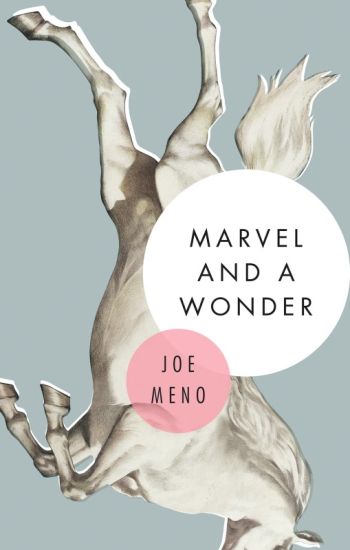
Joe Meno
Akashic Books
Hardcover $29.95 (336pp)
978-1-61775-393-0
Buy: Local Bookstore (Bookshop)
Meno has written a book that honors the values of old men and exposes their prejudices, where the young transcend their apathy to claim a fractured future.
Marvel and a Wonder, the compelling new novel by Joe Meno, is a character-driven story of loss in America’s heartland. It’s a story of flawed characters and a landscape that, despite occasional beauty, has been used up and passed over.
Jim Falls, age seventy-one, and his grandson Quentin, a childish sixteen, uneasily coexist on the family chicken farm in Indiana. The grandfather’s wife has died; the boy’s mother has abandoned him. The farm is in debt and the local town is failing. Even Jim’s attempt to do the right thing by helping a neighbor widow—and soften the taciturn bleakness with female companionship—ends in failure. Then a beautiful white racehorse is mysteriously delivered to the farm. Has their luck changed? But this is not a feel-good, come-from-behind story. The horse is stolen one evening by two brothers, and Jim and Quentin set chase, determined not to lose their chance at a fresh start.
Once Jim and Quentin are on the road, a handful of other characters are introduced, all involved with the horse, and the point of view shifts rapidly within chapters. The main antagonist is Rick West, the violent ranch hand who has been tasked with collecting both the horse and his employer’s runaway granddaughter. The most touching scenes are the one-sided dialogues where Quentin talks to his grandfather, struggling to maintain a connection and overcome his fear.
As with other quest narratives, the magnificent horse, now confined to a trailer with its physical needs largely ignored, focuses the plot and serves as a symbol. Quentin wonders if the horse is God; Jim believes it was sent by his dead wife. For everyone, it offers the possibility of escape.
Joe Meno is the editor of Chicago Noir: The Classics and the author of best-selling novels including Office Girl, Hairstyles of the Damned, and The Boy Detective Fails. With Marvel and a Wonder, he has written a book that honors the values of old men and exposes their prejudices, where the young transcend their apathy to claim a fractured future. It’s a book that despite its damaged characters consistently reaches for excellence: a wonder.
KAREN ACKLAND (November 19, 2015)
Lee Polevoi: “This dual biography of the legendary physicist J. Robert Oppenheimer and General Leslie Groves focuses on their unprecedented partnership in the creation of the Manhattan Project at Los Alamos Laboratories, where the first atomic bombs were developed and built. Told in exhaustive and often compelling detail.”
The General and the Genius
Groves and Oppenheimer, the Unlikely Partnership That Built the Atom Bomb
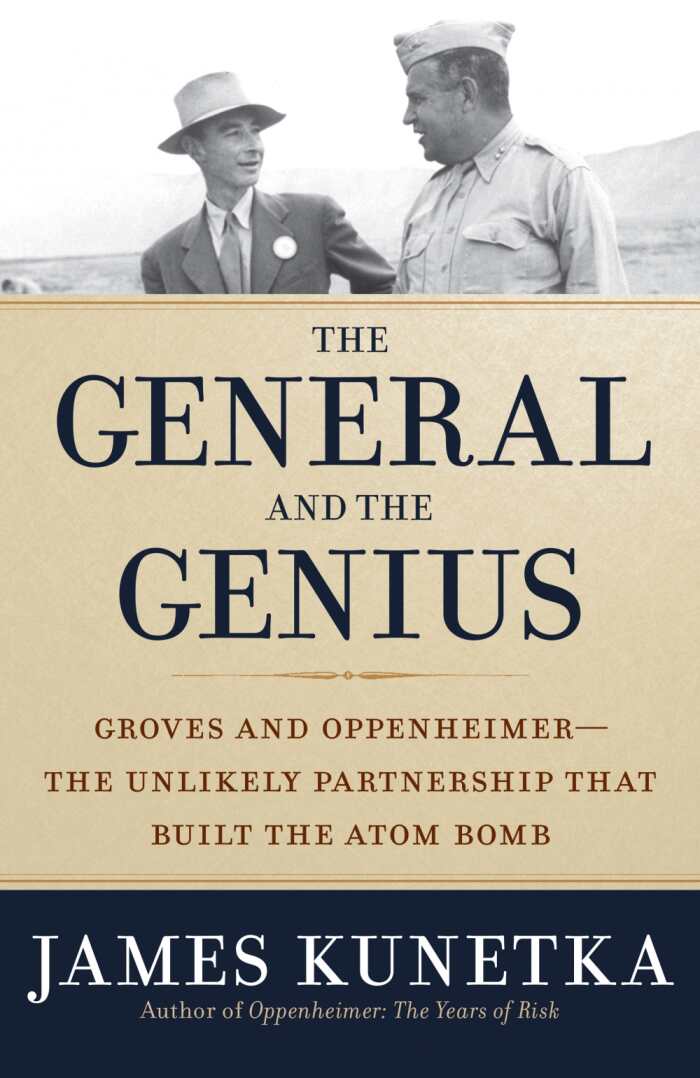
James Kunetka
Regnery History
Hardcover $29.99 (480pp)
978-1-62157-338-8
The origin story of nuclear weaponry is brought to compelling light through the experiences of the two men who spearheaded the Manhattan Project.
In the history of science and technology, there may be no more unlikely pairing than the two men who spearheaded the Manhattan Project—a vast enterprise tasked with designing and developing the first atomic bombs. Starting in 1943, General Leslie Richard Groves, a gruff, hard-charging officer of the Army Corps of Engineers, joined with the legendary physicist J. Robert Oppenheimer to lead an extraordinary force of thousands of scientists and military personnel in the creation of the ultimate weapon, which brought an end to the war in the Pacific.
This is the story told in exhaustive and often compelling detail by James Kunetka, a retired associate vice president of the University of Texas and the author of two previous books about Los Alamos and the Manhattan Project.
Kunetka does an excellent job of describing the challenges faced by the odd couple of Groves and Oppenheimer. With a nearly impossible deadline of less than three years, these men oversaw the unprecedented effort of building a weapon beyond anyone’s imagination and with consequences no one could accurately predict. Groves had “the expertise and skills necessary for the construction and management necessary to deliver uranium and plutonium, but not for the construction of the bombs themselves.” That task required the chain-smoking theoretical physicist known for his “ubiquitous cigarette or pipe and his slightly disheveled tweed jacket.”
It’s hard to imagine today, but during those fateful years, no one actually knew just how powerful the weapon they were designing might be. Among those present for the detonation of “Fat Man,” the first atom bomb prototype, in Alamogordo, New Mexico, some feared the explosion might “ignite the atmosphere.” While Kunetka expertly portrays the vast scientific enterprise from beginning to end, in recounting the days leading up to the pioneering test explosion on July 16, 1945, The General and the Genius achieves the suspense of a well-crafted thriller. For anyone interested in the “origin story” of nuclear weapons, this is must reading.
LEE POLEVOI (August 27, 2015)
Michelle Anne Schingler
